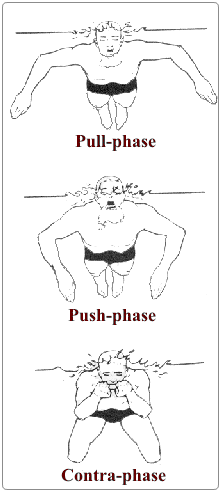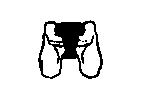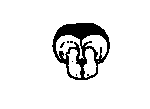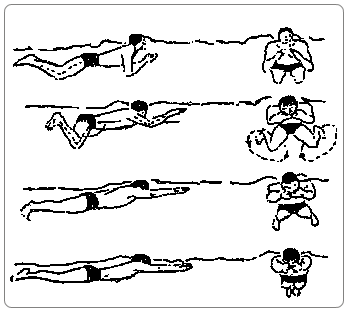Body position :
Legstroke :
Combination :
Remarks :
|
On the breast
Frog-kick, the biggest thrust of the swimming-stroke
Semi-short
In the Netherlands the first swimming-stroke which is learned
|
Introduction
The armstroke
The legstroke
The combination
Breathing
Frequently made mistakes with the breaststroke
Introduction
First of all, the breaststroke is a discontinuous stroke; the damming and
the stroke's movement is not continuous. In most countries, the breaststroke
is the first stroke that is taught. The breaststroke is the slowest swimming-stroke
of all competition strokes (butterfly, frontcrawl, backstroke and breaststroke),
but is also the stroke at which stick the most rules.



The armstroke
The function of the armstroke at a good breaststroker is to dam. With rookie
swimmers you do not see this yet: the arms are used to keep the head above
the water through the prop of the water. The breaststroke's armstroke is the
only armstroke at which the contra-phase (the phase in which hands and
arms are moved against the swimdirection) takes place under water. The arms
and hands do not come above the waterline during the swimming-stroke, which
causes of course a lot resistance.
We can divide the armstoke in several phases:
- Point of departure
- Glide-phase
- Pull-phase
- Push-phase
- Contra-phase
At the armstroke we see a large number of individual differences; executing
a more narrow or wider arm-movement, the length of the arm-movement and the
depth of the pull-phase.
Point of departure:
At the point of departure of the breaststroke, the body is in a horizontal position
with stretched elbows and the hands next to eachother, with the palms of the
hands pointed downwards, just below the waterline (see image).

Glide-phase:
 The glide-phase is the outlet of the point of departure and also the
moment that the legs get the opportunity their damming movement. In the
glide-phase, the hands search for grip on the water.
The glide-phase is the outlet of the point of departure and also the
moment that the legs get the opportunity their damming movement. In the
glide-phase, the hands search for grip on the water.
Pull-phase:
Just before the pull-phase the arms will turn inwards, so that the pull-phase,
with the inwards turned elbows, can begin. The arms will move obliquely
sideways and after that they move downwards. Besides, there will take place
a backward pointed movement with the arms. It is said that the pull-phase
ends when a swimmer can not see his little fingers anymore (with his head
pointed to the front).
Push-phase:
The pull-phase passes into the push-phase when the arms are just before
the shoulders (with the other competition swimming-strokes, this is right
under the shoulder). The hands and elbows are brought to eachother, at
which the hands still have a leading role. The elbows are linked up and
the palms of the hand turn to eachother.
Contra-phase:
The hands are brought to the front little by little. This happens on the
moment that the elbows almost come to the trunk. During this
contra-phase, in which the elbows are stretched again and the hands are
with palms of the hand turned to the bottom, there is a begin made of the
legmovement.


The legstroke
At the breaststroke, the legmovement (a so-called frog-kick) is the most important
part of the forward acceleration of the body. The damsurface consists of the inner
side of the ankle and the sole and the inner side of the lower part of the leg. In
general, the W-movement is the most used legstroke. The direction of movement
must be backwards as much as possible. We can roughly divide the legstroke into three
phases. For the sake of convenience we call these phases:
The point of departure is, just like with the armstroke, in an almost horizontal,
stretched position at which the legs are stretched and closed.
Phase 1:
In the first phase the legs are bend or drawed in. At this moment, the heels move
to the buttocks. The feet remain pointed backwards. The knees move a bit
away from eachother, but remain in the streamline of the body. We could
also call this the contra-phase of the legs, because they move against
the direction of movement.
Phase 2:
In this phase, the calfs and the feet are set open. The feet are then
almost at the buttocks. The feet are pulled up and turned outwards. The feet
also move outwards, so that there comes a W-bearing into the legs.
Phase 3:
 The outwards pointed footmovement is now turned backwards, at which the legs
are stretched and closed powerfully. During this round going movement the
feet go more outwards than the knees. The contra-phase of the legs passes
slowly into the W-bearing; there takes place a clear acceleration
during the closing of the legs (the damming phase). Nowadays this legstroke
is swum very often and is also known as the Whip-Action.
The outwards pointed footmovement is now turned backwards, at which the legs
are stretched and closed powerfully. During this round going movement the
feet go more outwards than the knees. The contra-phase of the legs passes
slowly into the W-bearing; there takes place a clear acceleration
during the closing of the legs (the damming phase). Nowadays this legstroke
is swum very often and is also known as the Whip-Action.
In the past the legstroke was executed like: drawing in, spreading and
closing, at which they thought that the stowage came from the closing of
the legs powerfully. This technique is called the Wedge-Action and
is now outdated.


The combination

The most important property of the cooperation of the arms and legs is that
the armstroke runs ahead on the legstroke. You start with the armstroke.
The legs are bent when the arms begin their stretch-phase. The stretch of
the arms will be completed earlier than the stretch-phase of the legs.
With that both contra-phases (of the arms and of the legs) fall virtually
together, which means a drop in speed and it makes the swimming-stroke
discontinu as mentioned earlier.
Breathing
Because the shoulders become above the waterline during the pull-phase,
this is the best moment to inhale. Especially because of the powerful
pull-phase of the arms, the shoulders go upwards, through which a minimal
movement of the head is enough to inhale. Breathing out has to take place
gradually during the stretching of the arms. Breathing out takes place
through mouth and nose. Because of breathing out under water the horizontal
body position is maintained.
Frequently made mistakes with the breaststroke
- The body position is not horizontal enough, because of an high
position of the head.
- The head is kept crooked, which causes a wrong body position.
- The armstroke is too big.
- The armstroke is executed with the fingers spread.
- There is no glide-phase.
- Too little difference in speed between the contra-phase and
the dam-movement.
- Executing the arm- and legstroke at the same time.
- Irregular breathing.
- Insufficient breathing out, which causes overflow of the lungs.
- The elbows are insufficiently connected.
- The legstroke is a so-called threestroke legstroke.
- Riding, where the knies are pulled in under the stomach.
- Scissor-kick, where the legs move asymmetric.

|


